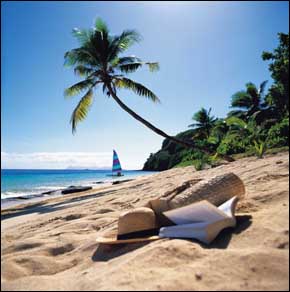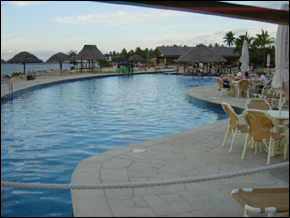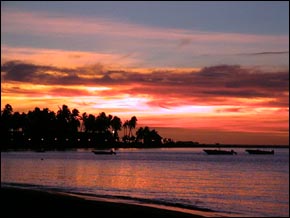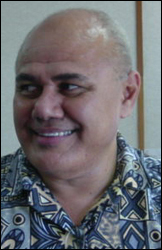 TOURISM,
A BILLION DOLLARS IN SEA, SAND AND SUN TOURISM,
A BILLION DOLLARS IN SEA, SAND AND SUN |

With nearly half a million tourists visiting Fiji
in a year, tourism is the country's largest source
of foreign exchange. It is also Fiji's single largest
export industry. In 2002, tourism contributed over
$521 million FJD from over 400,000 visitors (@ $260.5m
USD). The industry has been striking double-digit
growths in visitor arrivals for two consecutive
years now. Gross earnings have surpassed the half-a-billion
dollar mark. The industry now sets its goal of making
tourism a one billion dollar industry by 2007. "Tourism
in 2001 was 26 percent of Fiji's GDP", the
Fiji government's National Economic Summit in 2002
heard. "By 2007, tourism has the potential
to exceed $1 billion FJD (@ $500m USD). It is responsible
for the direct and indirect employment of some 45,000
Fiji Islanders".
The optimism that tourism earnings can reach the
billion-dollar mark also stems from the huge investment
plans of Air Pacific, Fiji's international carrier.
After announcing a $9.6m FJD profit in 2002 (@ $4.8m
USD), the airline a few months later announced an
expansion plan of $1,300 million FJD for its fleet
(@ $650m USD). This begins with the delivery of
two Boeing 747-400s on lease from Singapore Airlines,
the first in April and the second in June this year.
In addition, Air Pacific has ordered two Airbus
A330-300s and an option for two more. The first
Airbus is due for delivery in 2005 and the second
in 2007. If options were exercised, the second and
third Airbuses would join the flight in 2009 and
2011 respectively. "The scale of the order
makes it the biggest single commercial decision
ever made by any Fiji company," says the
South Pacific Aviation magazine. "It is
equivalent to 65 percent of Fiji's forecast 2003
GDP."
In the South Pacific region, Fiji is the number
one destination, catching twice more visitors than
French Polynesia, the number two destination. Fiji
has about 5,000 hotel rooms. But the Fiji
Visitors Bureau believes the country needs to
open at least one good 300-room resort annually
to cope with predicted demand.

While numerous small upmarket outer islands have
blossomed in the last 15 years, only one large development,
the recently completed 138-apartment Trendwest timeshare
complex has appeared. Now there are talks of pending
investments totalling $1 billion FJD (@ $500m USD),
and most of the planned activities are in the tourism
sector.
These include:
· Hilton Resort and spa: New Zealand developers
have begun work on a $170 million FJD scheme (@
$85m USD) for a 110 room hotel, 317 villas, five
restaurants, and two swimming pool complex at
Denarau Island, near the Nadi International Airport
with the first stage to open at the end of this
year.
· Work at Natadola Beach, 50 kilometres
from Nadi, has begun with the first stage of a
12-year scheme for building a resort town of about
15,000 people with at least four hotels and all
other amenities associated with such developments.
· Upmarket United States operator Rosewood
Hotels & Resorts will manage a 75 room property
now taking shape with accompanying villas at Taunovo
Bay, 55 kilometres from the capital Suva, by Coral
Coast Properties, a United States investor.
· Vulagi Lagoon, a 265-hectare property
with a two-kilometre beach, is a seven-minute
drive from Nadi Airport. With completed infrastructure,
local developer Charter Properties as a joint
venture, a partnership or for outright sale is
marketing the development with seven hotels, two
gold sites and also villa sites.
|

Recognising the huge potential the industry
holds, the Fiji Government in its 2003 budget upped
the Visitors Bureau's marketing budget from $11
million FJD (@ $5.5m USD) to $13m FJD per annum
(@ $6.5m USD). "Tourism will continue to
be a major sector contributing to growth,"
says Fiji's Commerce Minister Tomasi Vuetilovoni.
"It is therefore critical that we continue
to vigorously market Fiji abroad, projecting our
inherent advantages such as pristine environment,
isolation and the hospitality of our people to a
wider segment of the global market." Prime
Minister Qarase agrees tourism still holds the highest
growth potential for Fiji. It is an industry that
has always been growing and has tremendous potential.
"We have set the necessary incentives for
foreign investors, we have a clean environment and
our population is a big asset to tourism. We welcome
visitors and treat them very well so tourism will
continue to grow very strongly," says Qarase.

Australia and New Zealand are Fiji's traditional
source markets, and its Visitors
Bureau also runs promotions in North America
and Europe and now wants to extend its work into
Asia (India and China particularly) and South America.
"People say that Chinese and Indians are
different markets, that they look for other things
like better shopping, casinos and all that but same
thing was said about the Japanese and the Koreans
and they already come to Fiji," says Bill
Gavoka, head of the Fiji Visitors Bureau, that
spearhead Fiji's marketing as a tourist destination
abroad. "As soon as the number of visitors
from those countries grew in Fiji the people here
were able to provide facilities for them. Fiji people
can quickly adapt themselves to everything. I have
a lot of faith that Fiji will put up facilities
to suit the Chinese when they start arriving as
we have already done with the Japanese and the Koreans."
|

